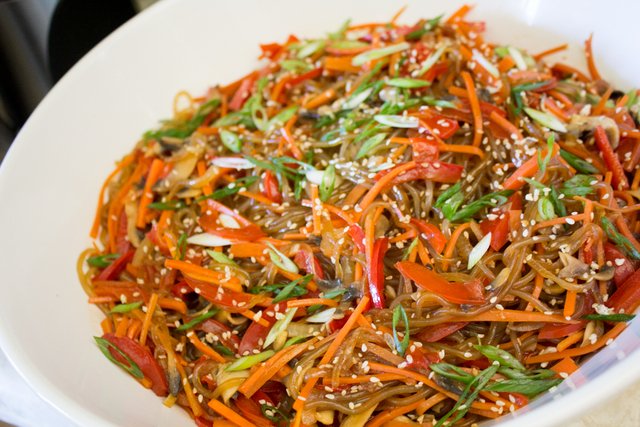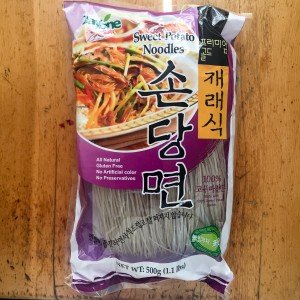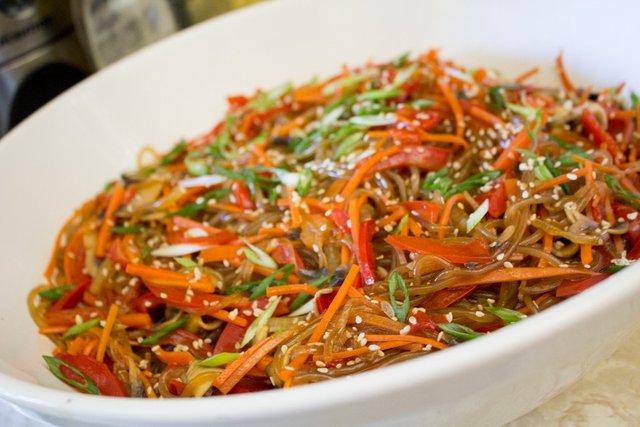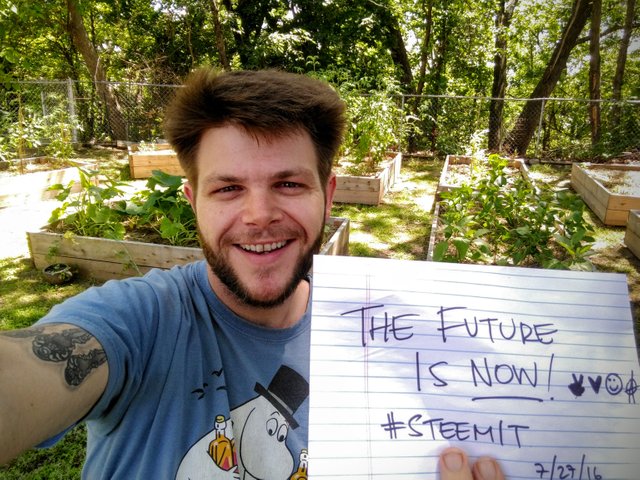Japchae recipe — DELICIOUS Korean stir-fried sweet potato noodles! Vegan-friendly, gluten free, and full of Seoul ;)

Growing up, my sweet, good-intentioned mother would pack me some less-than-desirable lunches: a boiled egg (which is never really polite to eat in public), a sandwich with cream cheese and jam, and a piece of fruit or some carrots. I would always mournfully stare at my classmates' lunches, wishing that my mother would send me to school with things like Gushers and Fruit by the Foot. But I especially envied my best friend, Caroline. She's Korean, and her mother would pack her lunches in thermoses that kept them warm—like magic! Every day, Caroline would happily eat her white rice, bulgogi, and my personal favorite, japchae, a slippery noodle dish with crunchy carrots, sweet red bell peppers, tender mushrooms, and a simple sauce (though exotic and mysterious to me back then!) made up of toasted sesame oil, soy sauce, and sugar.

I could eat pounds of japchae! I remember once going to Eugene's birthday party (another classmate of mine) and instead of pizza and ice cream, there was a Korean buffet! I vividly remember feeling like I'd hit the jackpot. There were giant platters of bulgogi, flanked by monolithic amounts of kimchi—spicy, sour fermented cabbage—perhaps the most well-known Korean dish, though surprisingly I'm not a huge fan myself. I also found another favorite of mine: kimbap, which is Korean-style sushi with many variations; usually a combination of sauteed vegetables, sweet pickled radish, white rice, and egg. I just remember seeing all of this food thinking, "I can eat as much of this as I want... without having to feel guilty about taking someone else's lunch... even with nothing of worth to trade!" It was one of the best feelings of my life, to date. When I finally made my way up to the buffet through the gathering of Korean mothers crowded around the food, Eugene's mom asked me what my favorite Korean dish was, and without hesitation I answered, "Japchae, of course!" And as they chatted amongst themselves about this teacher or that school or who was getting straight A's, they watched me pile a veritable mountain of the delicious noodles onto my giant plate with a giant smile.
Japchae (잡채) = "jap" (잡, "mixed and stirred") and "chae" (채, "vegetables")
Coincidentally, it didn't take long for Caroline's mother to catch on to the fact that I was eating the majority of her daughter's lunch every single day, so she began to pack me my own lunch alongside Caroline's, bless her soul. We had matching thermoses, each filled with containers of white rice, bulgogi, and japchae. From first until fifth grade, I feasted on homemade Korean food, and I'll always be thankful to Caroline and her family for keeping me so well-fed during the entire duration of elementary school.
Though it wasn't until about a week ago that I thought, "Maybe I could make japchae!" I had never once entertained the thought of making it myself because I considered it to be a Korean mother's specialty, and I—with my blonde hair and blue eyes—am far from a Korean mother. But I fought through that complex, studied a few different recipes, and finally gave it a go. Perhaps it's my nostalgia kicking in, but when I took that first bite, I knew it tasted exactly how it did all those years ago at San Jose Elementary School... and I think Caroline's mother would be proud.

Vegan Japchae recipe (Korean Stir-Fried Sweet Potato Noodles)
Japchae is a traditional Korean stir-fried noodle dish made with cellophane or glass noodles, made from sweet potato starch. It can be served warm, at room temperature, or chilled. This japchae recipe is vegan and gluten free.
Ingredients
- 3 tablespoons canola oil
- Salt and freshly ground white pepper
- 2 cups julienned carrots
- 2 cups julienned red peppers
- 2 cups thinly sliced white mushrooms
- 1 medium onion, thinly sliced
- 1 clove garlic, minced
- 16 oz. sweet potato starch noodles, also called dangmyeon (당면), cellophane noodles, or glass noodles (available at any Korean market, or via Amazon)
- 1/2 cup soy sauce (I ran out of Korean soy sauce and used Japanese and it turned out great, so whichever one you have on hand is fine)
- Scant 1/4 cup sugar
- 2 tablespoons toasted sesame oil
- 3 green onions, thinly sliced on a bias, for garnish
- 1 tablespoon toasted white sesame seeds, for garnish
Instructions
- Bring a large pot of water to boil for your sweet potato noodles. Cook them according to the directions on the package. Drain and rinse under cold running water. Set aside, covered on the counter. If your dangmyeon are very long, you may want to cut them into shorter lengths with kitchen shears.
- Heat 1 tablespoon of canola oil in a large skillet on medium-high heat. Add the carrots and season with salt and freshly ground white pepper, to taste. Cook them until they just begin to soften a bit, but you want them to retain a nice bite, so don't cook them for longer than 3 minutes. Remove them from the skillet.
- Add the remaining 2 tablespoons of canola oil. Once hot, add the bell peppers, mushrooms, onions, and garlic. Season with salt and freshly ground white pepper. These take slighly longer to cook, around 5 minutes, but again, you want them to keep their form. Once done, remove them from the skillet.
- Add the sugar and soy sauce to the same skillet and heat on low until the sugar dissolves.
- Add the rinsed, cooled, and cut noodles to the skillet with the soy sauce and sugar. Toss in your cooked veggies, along with the 2 tablespoons of toasted sesame oil. Make sure everything is evenly combined.
- Transfer to a large bowl or platter and garnish with the toasted sesame seeds and green onions. Serve immediately, or enjoy at room temperature or even cold. It will keep in the fridge for up to 2 days.

About me
My name is Randy Clemens and I am the author of The Sriracha Cookbook, The Veggie-Lover’s Sriracha Cookbook, and co-author of The Craft of Stone Brewing Co. I am a graduate of the California School of Culinary Arts and am featured in the award-winning Sriracha—a documentary film by Griffin Hammond.
In early 2015, I moved from Los Angeles to participate in the Free State Project, a geopolitical movement getting 20,000+ libertarians to relocate to New Hampshire to decrease the size and draconian reach of the government while protecting individual liberties. You can read more about me on my Steemit introduction post! And if one (or more) of the things I've written about here tickles your fancy, you can follow my musings on Twitter via @SrirachaBook and @RandyClemensEsq. This post was originally developed for and shared to my Wordpress blog by my good friend Julia Corlett, and I am reposting it here to Steem. Recipe, text, and dangmyeon photo by Julia Corlett; japchae photos by Randy Clemens. Some rights reserved under Creative Commons CC-BY-NC-SA 4.0.
Yes, this looks amazing. Gonna try this out sometime soon! Thanks for sharing :D
I LOVE Korean food. This recipe looks amazing. That's great that you wrote books on cooking and such. I live off of rice and noodly foods.
The future is in the present, but just after now. But close enough!
Hope you have enough of this for everyone, it looks yummy! :p
Thanks for sharing & happy steem-in!
Nice @randyclemens
Shot you an Upvote :)
This looks amazingly delicious @randyclemens keep up the good work